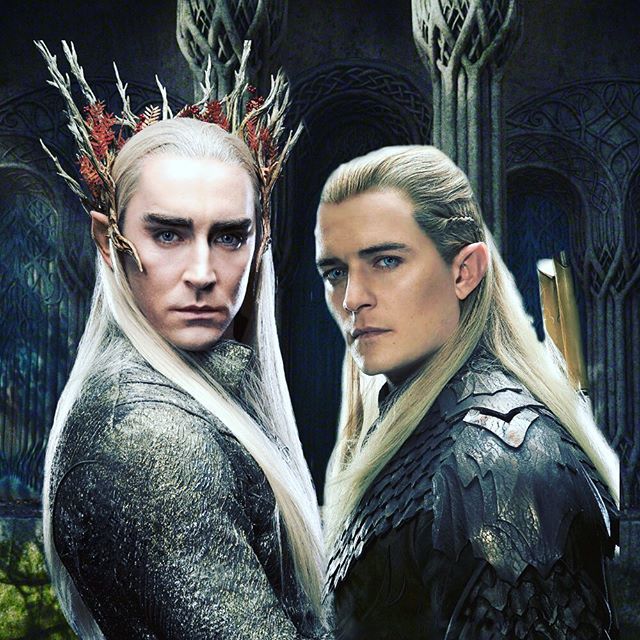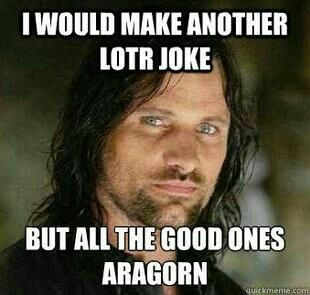Whenever you get Tolkien and Harry Potter fans together you risk some heavy words, and possibly some body slamming as the two groups can never agree on which world is the best one. Obviously the answer is Tolkien’s Middle Earth, but why? (This post is also present in the Harry Potter Group, and says the exact opposite. I don’t like being slammed.)

“I think she’s been drinking again, Ron.”
The basic thing about Harry Potter’s world is that it’s nice, imaginative, colorful, and ends about three feet around the corner at the end of Diagon Alley. You just get that perception that it’s a painted façade, and that if Harry makes one wrong turn, he’ll find himself floating in an empty void while J.K.Rowling frantically dreams up a new setting for the scene.
By contrast, anything happening anywhere in Middle Earth looks like it’s not the first time that sort of thing happens there, it probably won’t be the last, and, to put it quite simply, wherever there is, it doesn’t really give a rat’s ass about what is happening, because it’s been around long enough to have an opinion. Reading about the setting feels, in other words, like a real, living world, and the events which come together to form the Lord of The Rings trilogy are just the last chapter of a beautifully complex interaction of history, society and even geology.

In other words, in Harry Potter and the Sorcerer’s Stone, a troll inexplicably shows up inside Hogwarts. How did it get loose? There is some half-assed explanation about the bad guy trying to do random Bad Guy acts, but basically it’s because J.K.Rowling thought it would be a good moment for a troll to appear, more specifically to appear in the girls’ bathroom. Why? I DON’T KNOW WHY!
In The Fellowship of the Ring, the company encounters a Balrog. Why? Because they’re in Moria, underground, and Balrogs are underground. How did it get loose? The dwarves dug too deep. Where are the dwarves? KILLED BY THE FREAKING BALROG, NOW RUN! It just all fits together better.
But the true magic is even deeper, in the synapses and veins of the narration itself. It’s in the names of things and places which, I’m sure you noticed the first time you read LOTR, come very close to discouraging you from reading such a complicated text. But you read on, and as you read, you start to realize that the strange names are not just patched up word games like, say, “diagon alley” and “hogsmeade”. You have Ered Luin, and then Ered Mithrin, and realize that ered means “mountains”, and mithrin means “grey”. And then you remember that one of Gandalf’s nicknames is Mithrandir, which means ‘Grey Wanderer’ and you go ‘oooooooh!’
You never go ‘oooooh!’ in Harry potter, but there is, admittedly, more booger humor.

The secret to this incredible realism of Tolkien’s world is in his special linguistic alchemy: he started from the languages and built the elves around them. Then his elves had some serious argument over some drag costume jewelry or something like that, and they split up into two groups. So the languages divided into Quenya and Sindarin (and other dialects too, but you don’t hear elves use them unless they’re swearing). Then came the other races, including men. For men, specifically the horseriding Rohirrim, Tolkien played the ace up his linguistic sleeve: Anglo-Saxon (or Old English). Eoh is Old English for ‘horse’ which became Roh in Sindarin, and although “Rohan” is a Sindarin name, you may have noticed that many of the actual names of the horse-people in Rohan begins with “Eo”, such as Eomer, and Eowyn. Eowyn herself speaks Rohirric when at the end of “The King of the Golden Hall” she says “Westu, Theoden hal,” which is 100% Old English for “bless you Theoden”. It is possible to etymologically trace many Anglo-Saxon words to their modern form.
But the J to the double R T. didn’t stop there, because he wanted his other languages to sound realistic as well, and so he made sure they too could boast some of that cool etymology, only the other way around. For example he reverse engineered ancient Quenya so our modern languages appear to contain words which originate from it. I shall leave you with a few examples:
- Direct connection: the word I cited above, ered, comes from ancient Quenya oron, which means mountain. So does Greek oros.
- Association: the ancient Quenya word for ‘strong’ is taura. Taurus means ‘bull’ in Latin.
- The Geology: ok, follow me here, the verb root for ‘to fall’ in Quenya is tal_. For example: taltuva, ‘he fell’, and atal_, ‘has fallen’. The fabled island of Nùmenor, the peoples of which Aragorn is himself a descendant, is said to have been punished by the gods after its inhabitants rebelled against them. The punishment? It was made to sink down into the sea at the end of the Second Age. After the cataclysm, the sunken island was known as ‘The Downfallen’. In Quenya: Atalantë
oooooooh!

Ian Lahey writes fantasy and sci-fi. He really doesn’t want to be funny, he just fails at being serious. You can read more of Ian’s failures below, and even find links to his books.
Thanks to Marc Zender for correcting a linguistic blunder I’d made, which compromised my otherwise very serious article.
Don’t forget you can get a free short story just by signing up to my newsletter. You will also be invited to virtual book fairs and get the opportunity to win a $25 Amazon gift card.
Hits: 715
